Riqing Chen
AI-empowered Channel Estimation for Block-based Active IRS-enhanced Hybrid-field IoT Network
May 20, 2025Abstract:In this paper, channel estimation (CE) for uplink hybrid-field communications involving multiple Internet of Things (IoT) devices assisted by an active intelligent reflecting surface (IRS) is investigated. Firstly, to reduce the complexity of near-field (NF) channel modeling and estimation between IoT devices and active IRS, a sub-blocking strategy for active IRS is proposed. Specifically, the entire active IRS is divided into multiple smaller sub-blocks, so that IoT devices are located in the far-field (FF) region of each sub block, while also being located in the NF region of the entire active IRS. This strategy significantly simplifies the channel model and reduces the parameter estimation dimension by decoupling the high-dimensional NF channel parameter space into low dimensional FF sub channels. Subsequently, the relationship between channel approximation error and CE error with respect to the number of sub blocks is derived, and the optimal number of sub blocks is solved based on the criterion of minimizing the total error. In addition, considering that the amplification capability of active IRS requires power consumption, a closed-form expression for the optimal power allocation factor is derived. To further reduce the pilot overhead, a lightweight CE algorithm based on convolutional autoencoder (CAE) and multi-head attention mechanism, called CAEformer, is designed. The Cramer-Rao lower bound is derived to evaluate the proposed algorithm's performance. Finally, simulation results demonstrate the proposed CAEformer network significantly outperforms the conventional least square and minimum mean square error scheme in terms of estimation accuracy.
CausalCellSegmenter: Causal Inference inspired Diversified Aggregation Convolution for Pathology Image Segmentation
Mar 10, 2024Abstract:Deep learning models have shown promising performance for cell nucleus segmentation in the field of pathology image analysis. However, training a robust model from multiple domains remains a great challenge for cell nucleus segmentation. Additionally, the shortcomings of background noise, highly overlapping between cell nucleus, and blurred edges often lead to poor performance. To address these challenges, we propose a novel framework termed CausalCellSegmenter, which combines Causal Inference Module (CIM) with Diversified Aggregation Convolution (DAC) techniques. The DAC module is designed which incorporates diverse downsampling features through a simple, parameter-free attention module (SimAM), aiming to overcome the problems of false-positive identification and edge blurring. Furthermore, we introduce CIM to leverage sample weighting by directly removing the spurious correlations between features for every input sample and concentrating more on the correlation between features and labels. Extensive experiments on the MoNuSeg-2018 dataset achieves promising results, outperforming other state-of-the-art methods, where the mIoU and DSC scores growing by 3.6% and 2.65%.
OpenNDD: Open Set Recognition for Neurodevelopmental Disorders Detection
Jun 28, 2023Abstract:Neurodevelopmental disorders (NDDs) are a highly prevalent group of disorders and represent strong clinical behavioral similarities, and that make it very challenging for accurate identification of different NDDs such as autism spectrum disorder (ASD) and attention-deficit hyperactivity disorder (ADHD). Moreover, there is no reliable physiological markers for NDDs diagnosis and it solely relies on psychological evaluation criteria. However, it is crucial to prevent misdiagnosis and underdiagnosis by intelligent assisted diagnosis, which is closely related to the follow-up corresponding treatment. In order to relieve these issues, we propose a novel open set recognition framework for NDDs screening and detection, which is the first application of open set recognition in this field. It combines auto encoder and adversarial reciprocal points open set recognition to accurately identify known classes as well as recognize classes never encountered. And considering the strong similarities between different subjects, we present a joint scaling method called MMS to distinguish unknown disorders. To validate the feasibility of our presented method, we design a reciprocal opposition experiment protocol on the hybrid datasets from Autism Brain Imaging Data Exchange I (ABIDE I) and THE ADHD-200 SAMPLE (ADHD-200) with 791 samples from four sites and the results demonstrate the superiority on various metrics. Our OpenNDD has achieved promising performance, where the accuracy is 77.38%, AUROC is 75.53% and the open set classification rate is as high as 59.43%.
Beamforming Design for RIS-Aided AF Relay Networks
Feb 28, 2023Abstract:Since reconfigurable intelligent surface (RIS) is considered to be a passive reflector for rate performance enhancement, a RIS-aided amplify-and-forward (AF) relay network is presented. By jointly optimizing the beamforming matrix at AF relay and the phase shifts matrices at RIS, two schemes are put forward to address a maximizing signal-to-noise ratio (SNR) problem. Firstly, aiming at achieving a high rate, a high-performance alternating optimization (AO) method based on Charnes-Cooper transformation and semidefinite programming (CCT-SDP) is proposed, where the optimization problem is decomposed to three subproblems solved by CCT-SDP and rank-one solutions can be recovered by Gaussian randomization. While the optimization variables in CCT-SDP method are matrices, which leads to extremely high complexity. In order to reduce the complexity, a low-complexity AO scheme based on Dinkelbachs transformation and successive convex approximation (DT-SCA) is put forward, where matrices variables are transformed to vector variables and three decoupled subproblems are solved by DT-SCA. Simulation results verify that compared to two benchmarks (i.e. a RIS-assisted AF relay network with random phase and a AF relay network without RIS), the proposed CCT-SDP and DT-SCA schemes can harvest better rate performance. Furthermore, it is revealed that the rate of the low-complexity DT-SCA method is close to that of CCT-SDP method.
Three Efficient Beamforming Methods for Hybrid IRS-aided AF Relay Wireless Networks
Jan 07, 2023Abstract:In this paper, a hybrid IRS-aided amplify-and-forward (AF) relay wireless network is considered, where an optimization problem is formulated to maximize signal-to-noise ratio (SNR) by jointly optimizing the beamforming matrix at AF relay and the reflecting coefficient matrices at IRS subject to the constraints of transmit power budgets at the source/AF relay/hybrid IRS and that of unit-modulus for passive IRS phase shifts. To achieve high rate performance and extend the coverage range, a high-performance method based on semidefinite relaxation and fractional programming (HP-SDR-FP) algorithm is presented. Due to its extremely high complexity, a low-complexity method based on successive convex approximation and FP (LC-SCA-FP) algorithm is put forward. To further reduce the complexity, a lower-complexity method based on whitening filter, general power iterative and generalized Rayleigh-Ritz (WF-GPI-GRR) is proposed, where different from the above two methods, it is assumed that the amplifying coefficient of each active IRS element is equal, and the corresponding analytical solution of the amplifying coefficient can be obtained according to the transmit powers at AF relay and hybrid IRS. Simulation results show that the proposed three methods can greatly improve the rate performance compared to the existing networks, such as the passive IRS-aided AF relay and only AF relay network. In particular, a 50.0% rate gain over the existing networks is approximately achieved in the high power budget region of hybrid IRS. Moreover, it is verified that the proposed three efficient beamforming methods have an increasing order in rate performance: WF-GPI-GRR, LC-SCA-FP and HP-SDR-FP.
Enhanced-rate Iterative Beamformers for Active IRS-assisted Wireless Communications
Dec 16, 2022Abstract:Compared to passive intelligent reflecting surface (IRS), active IRS is viewed as a more efficient promising technique to combat the double-fading impact in IRS-aided wireless network. In this paper, in order to boost the achievable rate of user in such a wireless network, three enhanced-rate iterative beamforming methods are proposed by designing the amplifying factors and the corresponding phases at active IRS. The first method, called generalized maximum ratio reflection (GMRR), is presented with a closed-form expression, which is motivated by the maximum ratio combing. To further improve rate, maximize the simplified signal-to-noise ratio (Max-SSNR) is designed by omitting the cross-term in the definition of rate. Using the Rayleigh-Ritz (RR) theorem and the fractional programming (FP), two enhanced methods, Max-SSNR-RR and Max-SSNR-FP are proposed to iteratively optimize the norm of beamforming vector and its associated normalized vector. Simulation results indicate that the proposed three methods make an obvious rate enhancement over Max-reflecting signal-to-noise ratio (RSNR) and passive IRS, and are in increasing order of rate performance as follows: GMRR, Max-SSNR-RR, and Max-SSNR-FP.
MC-UNet Multi-module Concatenation based on U-shape Network for Retinal Blood Vessels Segmentation
Apr 07, 2022

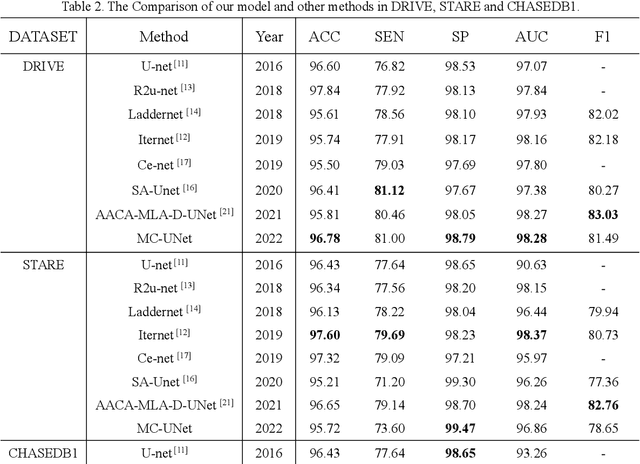
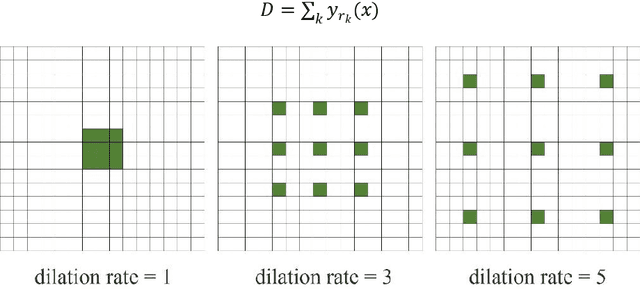
Abstract:Accurate segmentation of the blood vessels of the retina is an important step in clinical diagnosis of ophthalmic diseases. Many deep learning frameworks have come up for retinal blood vessels segmentation tasks. However, the complex vascular structure and uncertain pathological features make the blood vessel segmentation still very challenging. A novel U-shaped network named Multi-module Concatenation which is based on Atrous convolution and multi-kernel pooling is put forward to retinal vessels segmentation in this paper. The proposed network structure retains three layers the essential structure of U-Net, in which the atrous convolution combining the multi-kernel pooling blocks are designed to obtain more contextual information. The spatial attention module is concatenated with dense atrous convolution module and multi-kernel pooling module to form a multi-module concatenation. And different dilation rates are selected by cascading to acquire a larger receptive field in atrous convolution. Adequate comparative experiments are conducted on these public retinal datasets: DRIVE, STARE and CHASE_DB1. The results show that the proposed method is effective, especially for microvessels. The code will be put out at https://github.com/Rebeccala/MC-UNet
Long-Range Optical Wireless Information and Power Transfer
Jul 30, 2021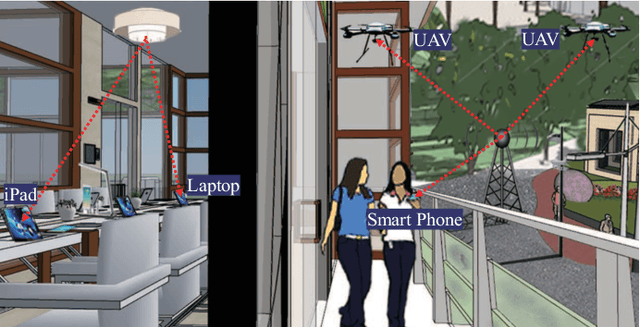
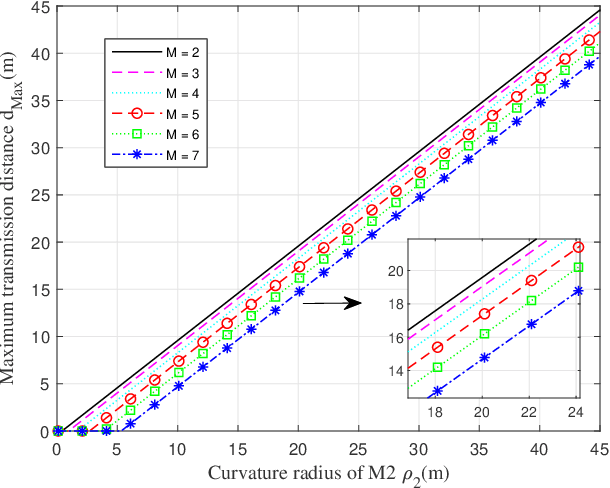
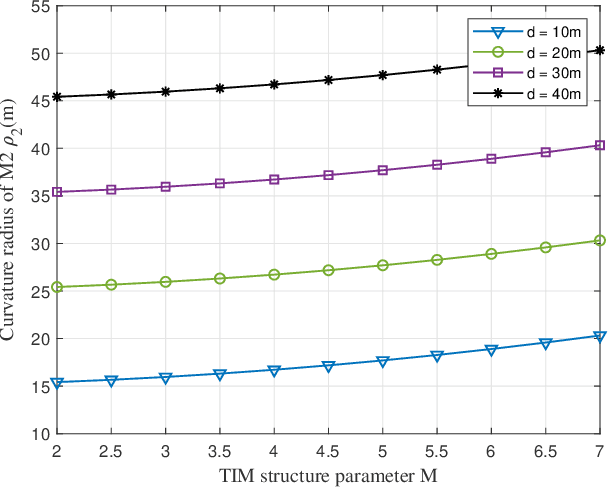
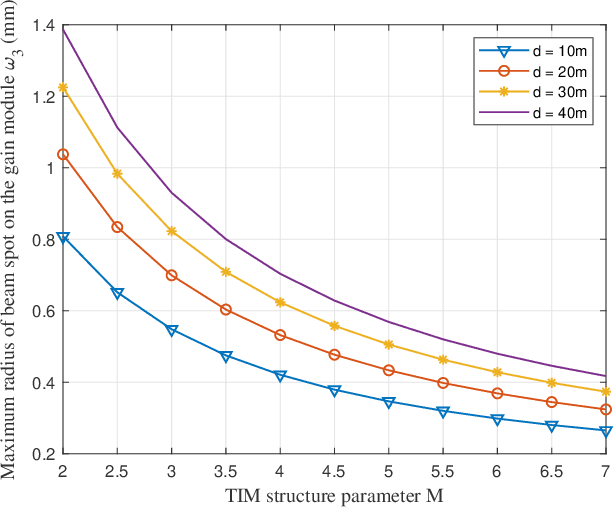
Abstract:Simultaneous wireless information and power transfer (SWIPT) is a remarkable technology to support data and energy transfer in the era of Internet of Things (IoT). In this paper, we propose a beam-compression resonant beam (BCRB) system for long-range optical wireless information and power transfer based on the telescope-like internal modulator (TIM). Utilizing the TIM, the resonant beam is compressed, making the transmission energy be further concentrated. Thus the over-the-air power loss produced by the beam diverged decreases, which enables the long-range SWIPT capability. We establish the analytical models of the transmission loss, the stability condition, the output power, and the spectral efficiency of the BCRB system, and evaluate the performance on the beam-compression, energy delivery, and data transfer. Numerical analysis illustrates that the exemplary BCRB system can deliver 6 W power and have 14 bit/s/Hz spectral efficiency over 200 m distance. Overall, the BCRB system is a potential scheme for long-range SWIPT in IoT.
 Add to Chrome
Add to Chrome Add to Firefox
Add to Firefox Add to Edge
Add to Edge